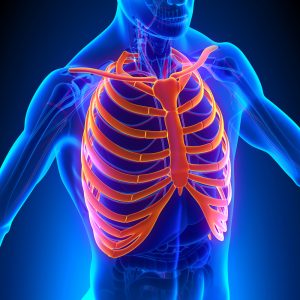Everything you need to know about Tietze Syndrome: what is it, symptoms, diagnosis, treatment and exercises!
Tietze’s syndrome is a rheumatic condition which is relatively unknown. It is a chronic inflammation of the cartilage in the chest. Tietze’s syndrome is not a serious condition but is accompanied by a nasty pain. The symptoms might resemble that of a heart infarct. Tietze’s syndrome may develop very slowly but can also become suddenly manifest. It’s equally present in men and women.
What is Tietze Syndrome?
The chest is built from ribs that are attached to the sternum through cartilage structures. This flexible cartilage enables the chest to move flexible upon breathing: swelling up upon inhalation and shrinkage again upon exhalation. In Tietze Syndrome, this cartilage gets inflamed. Through this, there is swelling below the sternum causing a nasty pain. This pain increases during coughing, sneezing, moving and sighing and mostly occurs at one side of the chest.
Tietze’s syndrome is sometimes confused with costochondritis. With this condition, the cartilage in the chest is also inflamed, but no swelling occurs. Costochondritis occurs more in women than in men.
What is the cause of Tietze Syndrome?
The cause of Tietze’s syndrome is not yet discovered. There are however strong clues that there are factors that play a role in the genesis of chronic inflammation and swelling of the cartilage in the thorax. It may originate from overload to the chest caused by lifting heavy objects, sustained coughing and work in a bent over position. However, Tietze’s syndrome may also arise from an accident with large effective force on the chest, respiratory infection, pregnancy and rheumatoid arthritis.
What are the symptoms of Tietze Syndrome?
The most important complaint with Tietze’s syndrome is pain in the sternum. This might increase in intensity upon deep inhaling, sighing, sneezing or coughing. Sometimes the pain might radiate towards back, neck, shoulder and arm. Besides, a cramped and compelling feeling might arise. The impression can then arise that there are heart problems. This can trigger such an appalling feeling that hyperventilation can sometimes occur. Because of the inflammations, the skin can get a reddish color. In some patients the function of the esophagus, stomach, intestines and lungs may be disturbed.
How is Tietze’s syndromediagnosed?
Tietze’s syndrome cannot be demonstrated by X-rays or a blood test. The swelling of the cartilage in the chest is not visible on X-rays. Also, the disease does not leave traces in the blood. Your doctor will therefore have to rely on your story regarding with what physical complaints you have to deal exactly. Usually, you will be referred to the hospital for a number of examinations. These aim to exclude other conditions – such as angina pectoris, gastric ulcer, pancreatitis, pulmonary embolism and heart disease.
How is Tietze’s syndrome treated?
There is no treatment for Tietze’s syndrome yet. The doctor will therefore focus on relieving the pain. In most cases, he will prescribe an anti-inflammatory analgesic (NSAID). In case of annoying side effects, the liquid Green-lipped mussel with Bio-Curcumin and Blackcurrant leaf can be tried as an alternative. This natural anti-inflammatory compound is active in the area around the joints. Also, the physician can give a corticosteroid injection to the painful place or decide to block the nerve between the ribs. One can also be referred to posture- or exercise therapist, such as physiotherapy, Cesar or Mensendieck. The complaints often disappear over time. However, in some patients Tietze’s syndrome progress into a chronic form.
Exercises for Tietze’s syndrome
In Tietze’s syndrome it is important to keep moving a lot. This will limit the consequences of this condition. In addition to keep moving enough, you can do these exercises daily.
Exercise 1: breathing
Take place on a chair. Close your eyes and concentrate on your breath follows through your nose and throat toward your chest and stomach. Keep your belly relaxed. Feel how your belly swells when you inhale and shrink again as you exhale. Do this exercise for 5 minutes. Finish with a deep breath and slowly blow it out.
Exercise 2: posture correction
Sit upright in a chair with your feet flat on the ground. Straighten your back and point your crest towards the ceiling. Put your chin in a little bit. Make your lower back hollow, leaving your shoulders slightly back and forth and the chest slightly forward. Try to correct your posture every 30 minutes.
Exercise 3: Stretch exercise middle back
Go on your hands and knees. First, make your back bulb while laying your head in the neck. Then you bend your back while bending your chin to the chest.

Share this page
Tweet

Download for free the booklet ‘Moving without pain’ with a retail value of $6.75 / £4.95.
Any questions? Please feel free to contact us. Contact us.






